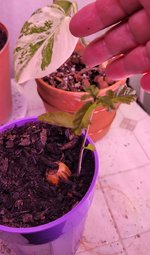You are using an out of date browser. It may not display this or other websites correctly.
You should upgrade or use an alternative browser.
You should upgrade or use an alternative browser.
Burly oak
- Thread starter GailC
- Start date
Eckhoffw
Masterpiece
The grow light purple haze always does it for me. 
Eckhoffw
Masterpiece
Is it Bur oak?
I love Bur oaks.
I love Bur oaks.
Adds a nice ambience lol. I'm not sure what kind it is but it could be bur. The tree I collected the nuts from do look like it, pretty small leavesThe grow light purple haze always does it for me.
After looking at more pics, I don't believe its a bur. All our oaks are cultivated so it could be any kind of white
Last edited:
Potawatomi13
Imperial Masterpiece
Astonishing skills, stupendous, outrageous, magnificent treeIsn't it magnificent and look at those photography skills
Gabler
Masterpiece
They’ll be yuge!
GGB
Masterpiece
Hey Gail, I'm glad to see you're still in the game. I was afraid you had gotten out of the hobby. Nothing more American than an Oak tree. we have more species than anywhere else on earth. In fact I think we might have the outright majority of them all together.
GGB
Masterpiece
Dammit, just fact checked myself. Mexico has the most. BUT we still have a ton
Gabler
Masterpiece
Dammit, just fact checked myself. Mexico has the most. BUT we still have a ton
I’m guessing you read that North America has the most and forgot that “America“ was preceded by “North.” Even so, I’m also surprised to hear that Mexico has the most oak species. I would have guessed Canada before Mexico.
rockm
Spuds Moyogi
Texas has about 50 species of oaks. Mexico has 160. New York has about 16 or so. The reasons for the numbers are interesting. The long and the short of it is that oaks are "niche" species, according to some research. The geography of Mexico and the South/Southwestern U.S. includes a wider variety of niche environments, from high alpine to subtropical, along with soils that drain well. Those conditions have allowed oaks to diversify tremendously in that range.I’m guessing you read that North America has the most and forgot that “America“ was preceded by “North.” Even so, I’m also surprised to hear that Mexico has the most oak species. I would have guessed Canada before Mexico.
More northern environments in the U.S. aren't as diverse, even though northern species of oaks originated the South/Southwestern/California/Mexican species-oaks moved from north to south, not the opposite, even though Mexico has the most species. It's also interesting that the next most oak diverse country is China. China and the eastern U.S. were once joined in a big land mass. There are many species of trees in the Eastern U.S. Appalachians whose closest genetic relatives are in China...
Interesting article on oak diversification I ran across that I paraphrased above:
American Oaks Share a Common Northern Ancestor | International Oak Society

How Oak Trees Evolved to Rule the Forests of the Northern Hemisphere
Genomes and fossils reveal their remarkable evolutionary history
BrianBay9
Masterpiece
Interesting articles! As much as oaks hybridize (wind driven pollination) I don't think anyone, including the oaks, know how many species there are.
Not sure this counts as still being in the game since all my other trees died in a heat wave.Hey Gail, I'm glad to see you're still in the game. I was afraid you had gotten out of the hobby. Nothing more American than an Oak tree. we have more species than anywhere else on earth. In fact I think we might have the outright majority of them all together.
Hoping to harvest some kind of maple this spring and maybe a crab apple too.
I do still have a couple juniper in pots I've not looked at in 3 years or so, really need to do something with them this year.
This oakis destined for my daughters property if the sale goes through, if not, it's mine
Potawatomi13
Imperial Masterpiece
Was it not the western US that joined to Asian continent while eastern US joined to Africa? Seems correct on tectonic plate mapsChina and the eastern U.S. were once joined in a big land mass.
LittleDingus
Omono
Was it not the western US that joined to Asian continent while eastern US joined to Africa? Seems correct on tectonic plate maps. Finish of geography class, now back to bonsai
Except the western US was pretty much always coastal.
Map of Pangea with modern country boarders:

Incredible Map of Pangea With Modern-Day Borders
Many millions of years ago, the world was one. This nifty map shows this Pangea supercontinent overlaid with modern country borders.
 www.visualcapitalist.com
www.visualcapitalist.com
Shibui
Imperial Masterpiece
Was it not the western US that joined to Asian continent while eastern US joined to Africa?
Hell of a lot has changed since pangea and since laurasia and gondwana.
I can't see any connection from west US to any other continents. East USA definitely connected to Asia way back.
South America part of gondwana but since has run into North America.
These connections are so far back in time they really cease to have meaning except for some shared plant genera.
rockm
Spuds Moyogi
You might want to supplement your geography class. The number of tree and plant species in Eastern North America that are related are pretty numerous. The reasons have been debated for quite some time. The supercontinent of "Laurasia" seems to play a key role in the similarities.Was it not the western US that joined to Asian continent while eastern US joined to Africa? Seems correct on tectonic plate maps. Finish of geography class, now back to bonsai

Plants in Appalachia are kissing cousins to those in China
Anyone who has ever planted a Chinese holly has surely wondered about the plant’s origin. We have native hollies here, but most of what we plant originated in Japan and China.
www.courier-tribune.com
Potawatomi13
Imperial Masterpiece
Observe vast thousands of miles of Canadian, Greenlandic, European landmass between NORTH USA America and china land areas. East American coast and China never neighbors by many thousands of miles . Fact of related plants, etc found both places never says these actually joined but had spread across distance between between glaciated periods. Read more closely please.
. Fact of related plants, etc found both places never says these actually joined but had spread across distance between between glaciated periods. Read more closely please.

A graphic of the supercontinent Pangaea (Image credit: Rainer Lesniewski via Getty Images)

Many millions of years ago, the world was one. This nifty map shows this Pangea supercontinent overlaid with modern country borders.
 www.visualcapitalist.com
www.visualcapitalist.com

A graphic of the supercontinent Pangaea (Image credit: Rainer Lesniewski via Getty Images)

Incredible Map of Pangea With Modern-Day Borders
Many millions of years ago, the world was one. This nifty map shows this Pangea supercontinent overlaid with modern country borders.

Last edited:
Potawatomi13
Imperial Masterpiece
Apologies for error.Except the western US was pretty much always coastal.
Map of Pangea with modern country boarders:

Incredible Map of Pangea With Modern-Day Borders
Many millions of years ago, the world was one. This nifty map shows this Pangea supercontinent overlaid with modern country borders.www.visualcapitalist.com
rockm
Spuds Moyogi
True, but misleading. Laurasia is the supercontinent involved (northern part of Gondwana supercontinent, pangea to the south) Laurasia was North America, Greenland, Europe, and northern Asia. Supercontinents formed broke apart and joined again over billions of years. All this is mostly academic. The fact remains that Asia and North America have thousands of related species that aren't shared elsewhere.Observe vast thousands of miles of Canadian, Greenlandic, European landmass between NORTH USA America and china land areas. East American coast and China never neighbors by many thousands of miles. Fact of related plants, etc found both places never says these actually joined but had spread across distance between between glaciated periods. Read more closely please.

A graphic of the supercontinent Pangaea (Image credit: Rainer Lesniewski via Getty Images)

Incredible Map of Pangea With Modern-Day Borders
Many millions of years ago, the world was one. This nifty map shows this Pangea supercontinent overlaid with modern country borders.
www.visualcapitalist.com
penumbra
Imperial Masterpiece
All of this is really fascinating. I have long wondered about the similarity of Asian plants and those of East Coast North America. Since it seemed to me that the eastern US and China were unlikely to ever be connected, I assumed that it was due to similar orientations.



